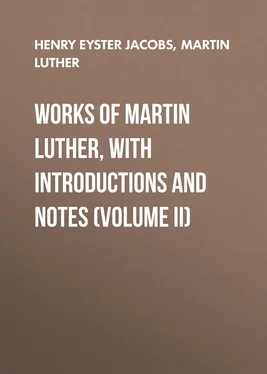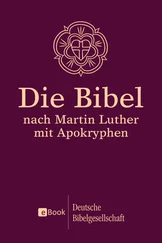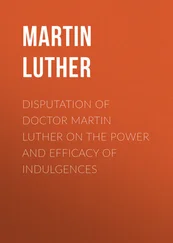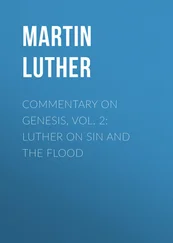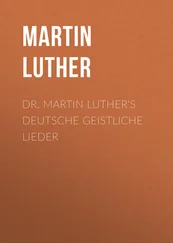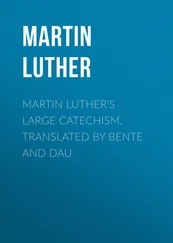The popes claimed temporal sovereignty over a strip of territory in Italy, beginning at Rome and stretching in a northeasterly direction across the peninsula to a point on the Adriatic south of Venice, including the cities and lands which Luther mentions. This formed the so-called "States of the Church." The attempt to consolidate the States and make the papal sovereignty effective involved Popes Alexander VI (1492-1503) and Julius II (1503-1513) in war and entangled them in political alliances with the European powers and petty Italian states. It resulted at last in actual war between Pope Clement VII and the Emperor Charles V (1526-1527). See Cambridge Modern History , I, 104-143; 219-252, and literature cited pp. 706-713; 727 f.
A free translation of the Vulgate, Nemo militans Deo .
The kissing of the pope's feet was a part of the "adoration" which he claimed as his right. See above, p. 108.
The three paragraphs enclosed in brackets were added by Luther to the 2d edition; see Introduction, p. 59.
The holy places of Rome had long been favorite objects of pilgrimage, and the practice had been zealously fostered by the popes through the institution of the "golden" or "jubilee years." Cf. Vol. I, p. 18, and below, p. 114.
Cf. the Italian proverb, "God is everywhere except at Rome; there He has a vicar."
Cf. Hutten's saying in Vadiscus : "Three things there are which those who go to Rome usually bring home with them, a bad conscience, a ruined stomach and an empty purse." (Ed. Böcking, IV, p. 169.)
The "golden" or "jubilee years" were the years when special rewards were attached to worship at the shrines of Rome. The custom was instituted by Boniface VIII in 1300, and it was the intention to make every hundredth year a jubilee. In 1343 the interval between jubilees was fixed at fifty, in 1389 at thirty-three, in 1473 at twenty-five years. Cf. Vol. I, p. 18.
Cf. the statements in the Treatise on Baptism and the Discussion of Confession , Vol. I, pp. 68 ff., 98.
The houses, or monasteries, of the mendicant or "begging" orders—the "friars." The members of these orders were sworn to support themselves on the alms of the faithful.
The three leading mendicant orders were the Franciscan (the Minorites, or "little brothers"), founded by St. Francis of Assisi (died 1226), the Dominican (the "preaching brothers"), founded by St. Dominic (died 1221), and the Augustinian Hermits, to which Luther himself belonged, and which claimed foundation by St. Augustine (died 430).
The interference of the friars in the duties of the parish clergy was a continual subject of complaint through this period.
By the middle of the XV Century there were eight distinct sects within the Franciscan order alone (See Realencyk. , VI, pp. 212 ff.), and Luther had himself taken part in a vigorous dispute between two parties in the Augustinian order.
St. Agnes the Martyr, put to death in the beginning of the IV Century, one of the favorite saints of the Middle Ages. See Schäfer, L. als Kirchenhistoriker , p. 235.
One of the most famous of the German convents, founded in 936.
The celebrated Church Father (died 420). The passages referred to are in Migne , XXII, 656, and XXVI, 562.
Or "community" ( Gemeine ). Cf. The Papacy at Rome , Vol. I. p. 345, note 4. See also Dass eine christl. Gemeine Recht und Macht habe , etc. Weimar Ed. XI, pp. 408 ff.
Or "congregation." See note 2.
i. e.. At a time later than that of the Apostles.
The first absolute prohibition of marriage to the clergy is contained in a decree of Pope Siricius and dated 385. See H. C. Lea, History of Sacerdotal Celibacy , 3d ed. (1907), I, pp. 59 ff.
The priests of the Greek Church are required to marry, and the controversy over celibacy was involved in the division between the Greek and Roman Churches.
Cf. Hutten's Vadiscus (Böcking, IV, 199).
i. e., Lie in Roman appointment.
i. e., The ministry in the congregation. See above, p. 119.
Quantum ragilitas humana permittit . A qualification of the vow.
i. e., Celibacy. Non promitto castitatem .
Fragilitas humana non permittit caste vivere .
Angelica fortitudo at coelestis virtus .
The court-jester was allowed unusual freedom of speech. See Prefatory Letter above, p. 62.
The laws governing marriage were entirely the laws of the Church. The canon law prohibited marriage of blood-relatives as far as the seventh degree of consanguinity. In 1204 the prohibition was restricted to the first our degrees; lawful marriage within these degrees was possible only by dispensation, which was not all too difficult to secure, especially by those who were willing to pay for it (see above, p. 96). The relation of god-parents to god-children was also held to establish a "spiritual consanguinity" which might serve as a bar to lawful marriage. See Benrath, p. 103, note 74, and in the Babylonian Captivity, below, p. 265.
This Luther actually did. When he burned the papal bull of excommunication (Dec. 10, 1520) a copy of the canon law was also given to the flames.
i. e., The marriage of the clergy.
On this sort of reserved cases see Discussion of Confession, Vol. I, pp. 96 ff.
"Irregularity" is the condition of any member of a monastic order who has violated the prescriptions of the order and been deprived, in consequence, of the benefits enjoyed by those who live under the regula , viz., the rule of the order.
The three kinds of masses are really but one thing, viz., masses for the dead, celebrated on certain fixed days in each year, in consideration of the enjoyment of certain incomes, received either out of bequeathed endowments or from the heirs of the supposed beneficiaries.
i. e., Even when the mass is decently said.
See above, p. 72, note 1.
See above, p. 104.
Das geistliche Unrecht .
The Treatise concerning the Ban , above, pp. 33 ff.
i. e., To those who teach and enforce the canon law.
Luther means the saint's-days and minor religious holidays. See also the Discourse on Good Works , Vol. I, pp. 240 f.
Or "congregation."
i. e., City-council.
Читать дальше
